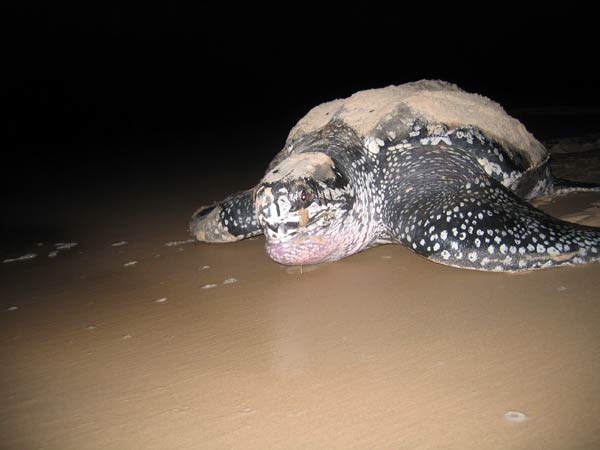Tracking a Mysterious Giant: Epic Turtle Migrations

The leatherback turtle is the colossus of the turtle world. They can grow up to 6.5 feet (2 meters) long and weigh in at 1,190 pounds (540 kilograms). Yet despite their heft, these giant reptiles are elusive.
Leatherbacks spend years at sea, and, although populations in the Pacific and North Atlantic oceans have been tracked, the ocean whereabouts of the world's largest population of leatherbacks in other ocean basins has remained a mystery.
"Nobody really had any idea of where they were going in the South Atlantic," said Matthew Witt, a post-doctoral research fellow at the University of Exeter in England.
Now, with the help of satellites, Witt has provided researchers with the first glimpse of the critically endangered turtles' epic migrations in the region.
Nighttime searches
Even with the high-tech space tools, tracking the gigantic turtles was a hands-on business for Witt.The turtles had to be tagged with transmitters before they could be tracked.
Witt spent several weeks a year walking deserted beaches in Gabon, on Africa's central Atlantic coast, searching through the dead of night for his large quarry — nesting female leatherbacks.
Sign up for the Live Science daily newsletter now
Get the world’s most fascinating discoveries delivered straight to your inbox.
Gabon's coast is home to more than 40,000 leatherbacks , according to some estimates, yet finding females to tag with a satellite transmitter wasn't easy. Witt would typically walk 12.5 miles (20 kilometers) a night, finding his way by starlight and moonlight — artificial lights disturb the turtles, Witt said — in search of disturbances in the sand, a telltale sign a female was nearby.
"They're huge, great things," Witt told OurAmazingPlanet. "Even at a few hundred meters you can see their tracks coming out of the sea and onto the beach."
Sending sand flying, and accompanied by a fair amount of noise — they grunt a lot, Witt said — the turtles dig nests about 3 feet (1 meter) down into the sand, chambers that typically contain about 100 eggs.
While a turtle is actually laying its eggs, it goes very quiet and still, Witt said, providing 20 or 25 minutes in which to attach a transmitter to a female's leathery back.
During a reproductive season, female leatherbacks lay about 1,000 eggs in about 90 days, an energy-intensive process.
Once finished, the females return to the high seas, where they must spend three or four years feeding and building up strength before they again return to land, for another exhausting round of nest-digging and egg-laying.
Three routes
Over the course of his five-year study, Witt tracked 25 females along three distinct routes in the Atlantic. Witt said he hopes that the new findings on where these massive turtles spend their time will be used to better focus conservation efforts.
Although some Atlantic populations appear to be doing well, the Pacific leatherback population has dropped a staggering 98 percent since the 1980s.
Much of the decline is due to human interference — egg collection is a problem, and the turtles are also snared in fishery lines.
Tracking the turtles with satellite transmitters is key for researchers, Witt said, but also creates a sort of dilemma.
"You need to collect this information, because you need it to help manage and conserve them," Witt said, "but you don't want to be too invasive, because there are such a limited number of them."
- In Images: Incredible Animal Migrations
- In Images: Tagging and Tracking Sea Turtles
- World's Cutest Sea Creatures
Reach Andrea Mustain at amustain@techmedianetwork.com. Follow her on Twitter @AndreaMustain
This article was provided by OurAmazingPlanet, a sister site to LiveScience.









